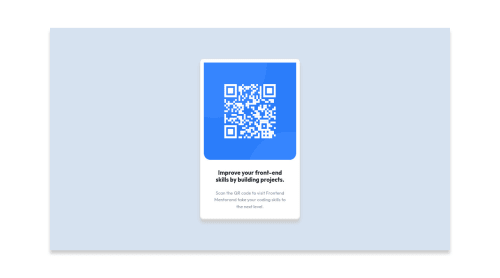FrontEnd Practice

Solution retrospective
I wasn't able to add border radius to the top part of the qr code(don't know the reason). While viewing the website in various sizes as because the card's position was changed to relative it comes out of the container.
Would be great if someone could check out the code and help.
Please log in to post a comment
Log in with GitHubCommunity feedback
- @owocoded
Why not try to give your img class in your html and do the same in your css. Something like this; .img{ border-radius: 10px; } I hope this is helpful. Happy coding.
- P@jakegodsall
Hi, some of the styling from bootstrap is overriding the style on the img tag for the top-left and top-right border radius.
I've not used bootstrap yet but inspecting your component using the Chrome dev tools it seems that
.card-img, .card-img-top { /border-top-left-radius: calc(0.25rem - 1px); border-top-right-radius: calc(0.25rem - 1px); }from
bootstrap@5.0.2/scss/mixins/_border-radius.scssis causing the troubles.
Hopefully someone with a bit more knowledge can provide more insight on this.
- @PhoenixDev22
Hi HIMANSHU,
Congratulation on completing this frontend mentor challenge. Excellent work! I have some suggestions regarding your solution:
- You should use
<main>landmark to wrap the card . HTML5 landmark elements are used to improve navigation experience on your site for users of assistive technology.
- Page should contain
<h1>. In this challenge , as it’s supposed to be a part of a whole page, you may use<h1>withsr-onlyclass hidden visually and present for assistive tech users. Then you can use <h2> instead of <h5>
- In my opinion, the image is an important content. The alternate text should indicate where the Qr code navigate the user: like
QR code to frontend mentornot describes the image.
- In order to center the card on the middle of the page , you can use the
flexboxproperties andmin-height: 100vhfor the<body>add a little padding to the body that way it stops the card from hitting the edges of the browser without any need for position: absolute or relative of the container and the card.
- Consider using rem and em units as they are flexible, specially for font size better to use rem. If your web content font sizes are set in absolute units, such as pixels, the user will not be able to re-size the text or control the font size based on their needs.Relative units “stretch” according to the screen size and/or user’s preferred font size, and work on a large range of devices.
- Remember a css reset on every project. That will do things like set the images to display block and make all browsers display elements the same.
Overall, your solution is good. Hopefully this feedback helps.
- You should use
Join our Discord community
Join thousands of Frontend Mentor community members taking the challenges, sharing resources, helping each other, and chatting about all things front-end!
Join our Discord